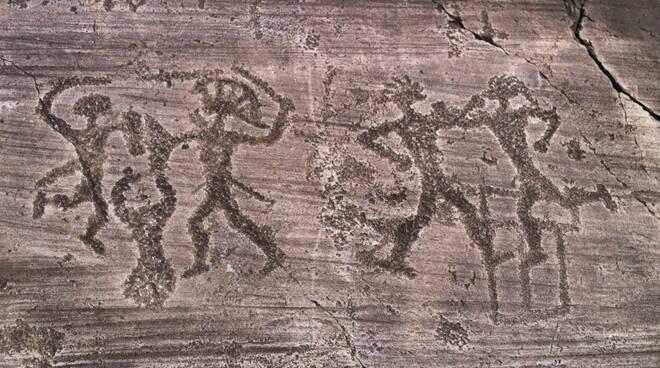Unesco Sites of Italy: Rock Drawings in Valcamonica
ITA:

Val Camonica, one of the largest valleys of the central Alps, located in eastern Lombardy (northern Italy), is home to the first Italian site registered on the UNESCO World Heritage List, in 1979.
The site contains one of the largest collections of prehistoric petroglyphs in the world - more than 140,000 symbols and figures carved in the rock over a period of 8,000 years, depicting themes connected with agriculture, navigation, war, hunting and magic, as well as geometric figures. The site is not yet fully explored and extends over an area of 70 kilometers.
The first traces of human presence in Val Camonica date back to at least 13,000 years ago, after glaciers began to melt. But it was only during the Neolithic era that the first inhabitants settled permanently in the valley. Some anthropomorphic figures (stylized human beings with their arms facing upwards) and certain topographical representations are traditionally traced back to this phase.
According to Unesco, the Rock Drawings of Valcamonica “constitute an extraordinary figurative documentation of prehistoric customs and mentality.”
The drawings vary from the spiritual to the material: people in a circle revering the sun, an elk with its head turned, a map of the valley with roads and houses. 5,000-year-old drawings from the Copper Age show the beginnings of agriculture and the shift from hunting to farming.
To make the petroglyphs, people used a hard stone against a soft rock surface. Archeologists believe that the sound made by striking rock was used in rituals; the sound connected humans to sacred beings and to the spirits who dwelled in the rocks.
The engravings were discovered at the beginning of the 20th century, and continue to be studied today, because, as Unesco points out, “they teach us much about the history of mankind.”
La Val Camonica, una delle valli più estese delle Alpi centrali, situata nella Lombardia orientale (nord Italia), ospita il primo sito italiano iscritto nella Lista del Patrimonio Mondiale dell’UNESCO, istituito nel 1979.
Il sito contiene una delle più grandi collezioni di incisioni rupestri al mondo: più di 140.000 simboli e figure scolpiti nella roccia lungo un periodo di 8.000 anni, raffiguranti temi legati all'agricoltura, alla navigazione, alla guerra, alla caccia e alla magia, oltre che figure geometriche. Il sito non è ancora stato completamente esplorato e si estende su un'area di 70 chilometri.
Le prime tracce di presenza umana in Val Camonica risalgono ad almeno 13.000 anni fa, dopo che i ghiacciai iniziarono a sciogliersi. Ma fu solo durante il Neolitico che i primi abitanti si insediarono stabilmente nella valle. A questa fase sono tradizionalmente riconducibili alcune figure antropomorfe (esseri umani stilizzati con le braccia rivolte verso l'alto) e alcune rappresentazioni topografiche.
Secondo l'Unesco, i graffiti rupestri della Valcamonica “costituiscono una straordinaria documentazione figurativa sugli usi e la mentalità preistorici”.
I disegni variano dallo spirituale al materiale: persone in cerchio che riveriscono il sole, un alce con la testa girata, una mappa della valle con strade e case. I disegni risalenti all'età del rame (5.000 anni fa) mostrano le origini dell'agricoltura e il passaggio dalla caccia all'agricoltura.
Per realizzare le incisioni rupestri, gli uomini preistorici usavano una pietra dura sfregata contro una superficie di roccia morbida. Gli archeologi ritengono che il suono prodotto dal battere la roccia fosse usato durante i rituali; il suono collegava gli esseri umani agli esseri sacri e agli spiriti che dimoravano nelle rocce.
Le incisioni furono scoperte all'inizio del XX° secolo e continuano ad essere studiate ancora oggi, perché, come sottolinea l'Unesco, "ci insegnano molto sulla storia dell'umanità".











